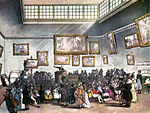In common value auctions the value of the item for sale is identical amongst bidders, but bidders have different information about the item's value. This stands in contrast to a private value auction where each bidder's private valuation of the item is different and independent of peers' valuations.[1]
A classic example of a pure common values auction is when a jar full of quarters is auctioned off. The jar will be worth the same amount to anyone. However, each bidder has a different guess about how many quarters are in the jar. Other, real-life examples include Treasury bill auctions, initial public offerings, spectrum auctions, very prized paintings, art pieces, antiques etc.
One important phenomenon occurring in common value auctions is the winner's curse. Bidders have only estimates of the value of the good. If, on average, bidders are estimating correctly, the highest bid will tend to have been placed by someone who overestimated the good's value. This is an example of adverse selection, similar to the classic "lemons" example of Akerlof. Rational bidders will anticipate the adverse selection, so that even though their information will still turn out to have been overly optimistic when they win, they do not pay too much on average.
Sometimes the term winner's curse is used differently, to refer to cases in which naive bidders ignore the adverse selection and bid sufficiently more than a fully rational bidder would that they actually pay more than the good is worth. This usage is prevalent in the experimental economics literature, in contrast with the theoretical and empirical literatures on auctions.
- ^ Athey, Susan; Segal, Ilya (2013). "An Efficient Dynamic Mechanism" (PDF). Econometrica. 81 (6): 2463–2485. CiteSeerX 10.1.1.79.7416. doi:10.3982/ECTA6995.

